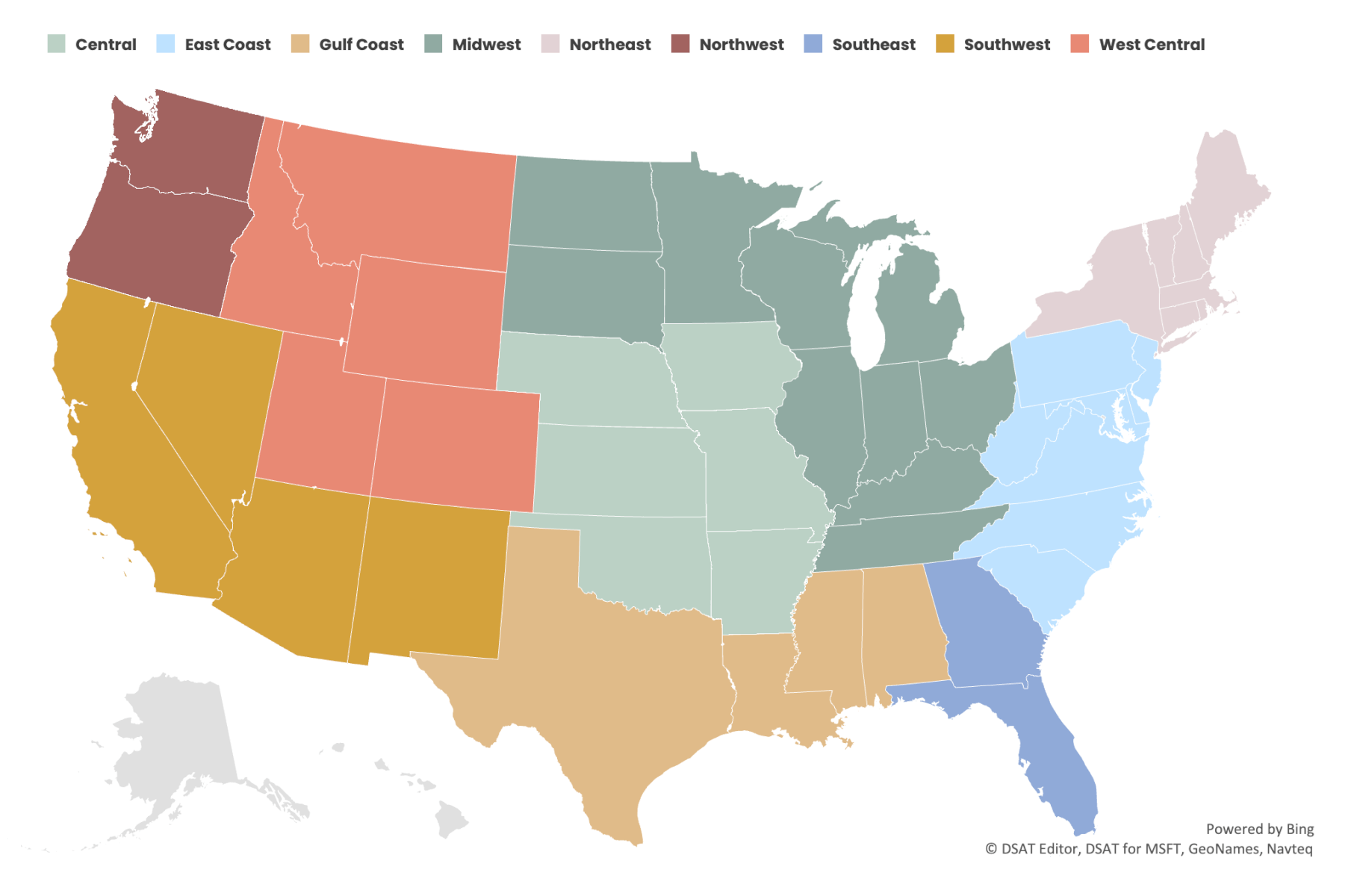Defined Regions

CoreLogic curates this monthly bulletin of regional construction cost insights, which are reflected in the CoreLogic Claims Pricing Database. We combine the current month’s pricing data with four common loss scenarios to create models illustrating market impacts that are applied across nine regions and compared month over month and year over year.
Our experts provide detailed analyses of changes and trends to provide additional insight into key drivers. View our Construction Database Pricing Methodology white paper to gain additional insight into how we populate cost values.
July Pricing Insights
2024 Updates From the CoreLogic Pricing Analysis and Delivery Team
The CoreLogic Pricing Analysis and Delivery Team continues to research labor costs and industry best practices for all construction categories within the Claims Construction Cost Database. To standardize labor trade assignments in the CoreLogic Pricing Database, CoreLogic will continue implementing incremental monthly changes throughout 2024 for each respective trade category.
For the June pricing database release, we standardized labor trades in the following categories: Antenna and Satellite Dishes; Vents; Cleaning Upholstery; Moisture Protection; Cleaning Lamps and Vases; Cleaning General Items; Demolition; Cleaning Electrical Items; Wall Coverings; Interior Furnishings; Metal Structures; Paneling and Wood Wall Finishes; Interior Lath and Plaster; Contents Packing; Handling and Storage; Fireplace; Temporary Repairs; Outbuildings; Drywall; Masonry; Light Fixtures; Insulation; Stairs; and Fencing.
For the July 2024 Claims Construction Cost Database release, we standardized labor trades in the following categories: Finish Carpentry; Equipment Rentals; Cabinetry; Toilet and Bath Accessories; Concrete and Asphalt; Electrical; and Contents-Clean Appliances.
In the August Pricing Database, we will align labor trade assignments in the following categories: Tile; Mobile Homes Skirting and Setup; Awnings and Patio Covers; Landscaping; HVAC; Floor Coverings; Permit and Fees; and Exterior Furnishings.
Additionally, we will increase subcontractor overhead and material markup allowances across all trades through most of 2024. This adjustment will lead to a single-digit upward movement in labor trade rates and material prices. These adjustments reflect escalating costs for subcontractors, such as increased vehicle acquisition and maintenance, real estate expenses, software, general office expenses, and job-site material delivery charges. Customers will also notice above-average upward labor rate adjustments in certain markets in the Western region through Q3.
CoreLogic will update the Construction Pricing Database Methodology white paper in the coming months to reflect additional considerations not previously outlined.
Line-Item Updates and Ongoing Refresh
The July 2024 Claims Construction Cost Database release will refresh the Antenna and Satellite Dishes; Awnings and Patio Covers; Metal Structures and Components; and Outbuilding categories.
In July or August 2024, the Construction Cost Database update will begin to include a caulking component within most paint-grade interior trim items. Full details regarding interior trim impacts will be included in the appropriate Claims Construction Cost Bulletin.
The August release is expected to refresh the Windows and Window Screen categories. We will continue the realignment process on a rolling monthly basis for all categories within the Claims Construction Cost Database, targeting completion by December 2024 or early Q1 2025. Looking forward, the August 2024 Claims Construction Cost Database will include a caulking component within most paint-grade interior trim items. We will provide full details regarding the impacted interior trim items in the applicable Claims Construction Bulletin.
Fire/Lightning (Large Loss) Insights: 12-Month Trend

In this category, large loss claims are modeled from a typical fire loss where all components of a home’s construction are affected. Losses typically exceed $100,000.
- The fire/lightning scenario increased by an average of 2.9% month over month. Regions with larger-than-average increases include the Northwest (4.4%), Southeast (3.3%), and West Central (7.8%) regions. General labor rates in these regions have also increased significantly, rising by 14.7% in the Northwest, 12.8% in the Southeast, and 17.7% in the West Central regions.
- Compared to this time last year, this loss scenario averages 9.6% higher. Decreases in framing and finish carpentry material pricing helped offset gains in drywall materials and general labor rates over this period (See Table 1).
| Material | Average Change From July 2023 Pricing |
| Framing Materials | -8% |
| Drywall Materials | 8.5% |
| Finish Carpentry Materials | -1.7% |
| General Labor | 18.9% |
Wind/Hail (Exterior/Roof) Insights: 12-Month Trend

This category represents losses due to wind and/or hail weather activity. Restoration from this damage requires roof replacement, partial siding replacement, and accompanying accessories.
- Compared to other loss scenarios, the wind/hail scenario shows a 15.6% gain year over year, which is the largest average gain. Since July 2023, increases in roofing labor (12%), siding labor (25.9%), and roofing materials (3.2%) have fueled this growth. Conversely, reductions in fencing materials (6.8%) and siding materials (3.2%) tempered growth during this period.
- Over the last month, wind/hail has developed by 2.6% on average. Notably, roofing labor increased by 4% and siding labor by 4.1%. Major material components for this loss scenario have moved incrementally (+/-1%) since June 2024.
- From May 16 to June 15, storms with 1” or greater hail impacted 35 states. CoreLogic Weather Verification Services estimated that more than 2.3 million homes may have been affected by hail associated with these storms. Texas was hit hardest, with significant storms also occurring in Missouri, Colorado, and Oklahoma.
Water (Interior Reconstruction) Insights: 12-Month Trend

Moderately complex losses are modeled for the interior water loss scenario using the bathroom as the origin of loss where a combination of replacement and repair of common household finishes is required.
- This loss scenario developed by an average of 2.6% monthly. Increases in painting labor (4.2%) and cleaning labor (8.6%) drove up prices but this trend was offset by a decrease in painting materials (1.2%).
- Year over year, average pricing for the interior reconstruction loss scenario is up 9.9%. Table 2 lists some categories affecting this movement.
| Category | Average Change From July 2023 Pricing |
| Painting Labor | 10.7% |
| Cleaning Labor | 15.2% |
| Cabinetry Materials | 17% |
| Painting Materials | -1.4% |
Water Mitigation (Drying) Insights: 12-Month Trend

Typical drying costs for a residential structure include water extraction, removal of wet material, and drying equipment usage.
- Since last month, pricing for the water mitigation loss scenario increased by an average of 3.3%.
- Since July 2023, pricing increases averaged 9.9% across all regions.
- Since last month, water mitigation technician labor rates, a major component of this loss scenario, increased by an average of 2%. Since July 2023, labor rates increased by 7.8% on average. These increases influenced both the month-over-month and year-over-year pricing for this loss scenario.
About CoreLogic Data Research
CoreLogic develops this report using up-to-date materials and labor costs. CoreLogic’s team of analysts continuously researches hard costs such as labor, material, and equipment, including mark-ups. CoreLogic updates its database every month accordingly.
Our research also covers soft costs, such as taxes and fringe benefits, for reconstruction work performed as part of the insurance industry. CoreLogic monitors demographics and econometric statistics, government indicators, and localization requirements, including market trends from thousands of unique economies throughout the U.S.
Other factors in this process include the following:
- Wage rates for more than 85 union and non-union trades
- Over 100,000 construction data points
- Productivity rates and crew sizes
- Building code requirements and localized cost variables
Additionally, we validate cost data by analyzing field inspection records, contractor estimates, phone surveys, and both partial and complete loss claim information.
Please complete the online form to provide feedback or request information on any items in our construction database. Please contact your sales executive or account manager for additional explanations or questions. A more detailed methodology explanation can be found in our Construction Database Pricing Methodology white paper.
About CoreLogic
CoreLogic is a leading global property information, analytics and data-enabled solutions provider. The company’s combined data from public, contributory and proprietary sources includes over 4.5 billion records spanning more than 50 years, providing detailed coverage of property, mortgages and other encumbrances, consumer credit, tenancy, location, hazard risk and related performance information. The markets CoreLogic serves include real estate and mortgage finance, insurance, capital markets, and the public sector. CoreLogic delivers value to clients through unique data, analytics, workflow technology, advisory and managed services. Clients rely on CoreLogic to help identify and manage growth opportunities, improve performance and mitigate risk. Headquartered in Irvine, Calif., CoreLogic operates in North America, Western Europe and Asia Pacific. For more information, please visit www.corelogic.com.
NOTE: The building material, labor, and other cost information in this bulletin is generated using research, sources, and methods current as of the date of this bulletin and is intended only to provide an estimated average of reconstruction cost trends in the specified general geographic regions of the United States. This cost information may vary further when adjusting claim values for specific property locations or specific business conditions.


